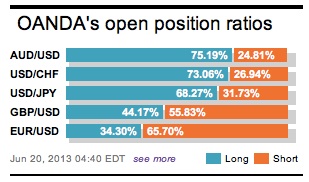Yep, Bernanke and his fellow buddies were hawkish, but being aggressively so against expectations has reopened many of this month’s asset classes price wounds. Yesterday, the Fed managed to tick the message transparent box. In their communiqué and press conference, they have clearly got across their ‘tapering’ stance message – it’s on the table. The Fed is not poised to raise rates anytime soon, but assuming key data keeps improving, they will look to trim the monthly $85-billion bond purchase later this year. Their precise message has resulted in aggressively pushing US Treasury yields to reach 15-month highs, allowing the “mighty buck” to rule once again.
The Fed committee has judged that the downside risks to the outlook for the economy and the specifically the labor market has lessened over the last eight-months. Chairman Bernanke stated: “if the subsequent data remain broadly aligned with our current expectations for the economy, we would continue to reduce the pace of purchases in measured steps through the first half of next year, ending purchases around midyear”. A percentage of the market had been expecting for the first cutback in the Fed’s $85b a month QE3 program asset to begin in September. However, with the current aggressive asset pricing is indicating that the end of July’s FOMC meet is now in play. This is of course is assuming that the US labor market data does not deteriorate and inflation expectations hold near their new levels.

If the Fed’s counter punch was not enough, then the ‘risk’ knock out potentially comes from China–the anointed global savior throughout this ongoing six-year crisis. The overnight downbeat sentiment in Asia is supported by China’s disappointing manufacturing data. The country’s manufacturing has contracted with new export orders at the worst level in four-years. China’s HSBC flash manufacturing PMI shrank at a faster pace to 48.3 this month versus last months 49.2 print – a number very much in contracting territory. The new export orders dipped to 44 versus 48.9 last month. However, the optimistic twist could be that the PMI print is collected from a larger sample of SME’s, who may be “less responsive to the recent increase in lending from big banks and infrastructure projects.” Remember, almost anyone can express away or postpone most negativity’s.
This “summer of silence” will end up being a myth. Upbeat Euro-PMI’s this morning is giving the 17-member single currency little solace. With the Fed dominating market direction, the better than expected composite prints from France, Germany and Euro-zone has been very much drowned out, discounted and ignored. Anxiety, mass liquidation and margin requirements is pushing G10 currencies to test some key support levels, as US yields force the USD to the ‘top of the pile’. Even the mighty Germany, the Euro-zone’s backbone, is unable to help with its expanding business activity for this month. The EUR, along with the other major currencies, are being exposed to key technical levels. The market can expect the option market to cause further significant angst in the North American session later this morning.

The EUR’s minimum downside target of 1.3170 is in danger of being triggered early, potentially opening up a route to 1.3110. The market will be expected to remain short-term bearish as long as we stay below 1.3325. For the Yen, despite Japanese repatriation continuing, the dollar remains to be bought on dips-above ¥98.00, the next target is ¥99.00+. Last week, Japanese residents sold -¥402b of foreign bonds, up slightly from the preceding week. Even the selling of foreign equity continues, although at a slower pace. PM Abe and BoJ will be much relieved with the markets current price action, but for how long?
Many investors will start this day off scrambling, just like yesterday after the Fed’s press conference. The market is still trying to get its head around the Fed’s comments, China slowing and Europe somewhat doing better – for the time being at least. Today’s initial investor reaction will have more to do with liquidity, margin fulfillments and requirements and less to do fundamentals, even though they should not be drowned out completely.

Analysts expect US existing home sales to edge up slightly last month (+5m units), and potentially challenge the three-year high print. With jobs a Fed key metric, this week’s US initial claims is expected to be little changed (+340k). The Philly Fed manufacturing survey is also looking for an improvement from -5.2 to -2.0 this time around. Now that the market is confirming that ‘helicopter’ Ben and fellow Fed friends company are more hawkish-than-expected, investors will be inclined to expect further tightening on the better fundamental data headlines. Any fundamental surprise has the potential to generate much sharper dollar gains in the short-term.

Other Links:
Are EUR Bulls Prepared For The FOMC Decision?
Dean Popplewell, Director of Currency Analysis and Research @ OANDA MarketPulseFX
This article is for general information purposes only. It is not investment advice or a solution to buy or sell securities. Opinions are the authors; not necessarily that of OANDA Corporation or any of its affiliates, subsidiaries, officers or directors. Leveraged trading is high risk and not suitable for all. You could lose all of your deposited funds.



